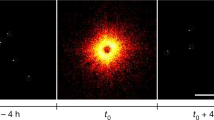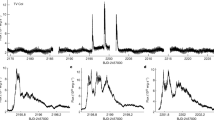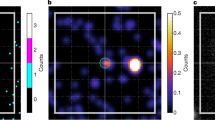Abstract
GQ MUS (Nova Muscae 1983) was the first classical nova from which X-rays were detected during outburst1'2. Those Exosat observations were consistent with thermonuclear burning on the surface of a white dwarf emitting 1037–1038 erg s−1 at (3.0–3.5) × 105 K or with shocked circumstellar material emitting 1035 erg s−1 by thermal bremsstrahlung at 107 K. Here we report the detection by the Rosat satellite3 of GQ Mus as a very soft black-body-like source. If the observed X-ray flux is being radiated at the Eddington luminosity (1038 erg s−1) from a one-solar-mass white dwarf, its effective temperature must be ∼3.5 × 105 K. We conclude that the white dwarf is burning hydrogen-rich material near its surface. GQ Mus is, however, the only one of 26 recent novae detected in the all-sky Rosat survey; this suggests that either most novae eject all their accreted material during outburst, or GQ Mus is now burning recently accreted material. GQ Mus appears identical to the supersoft X-ray sources CAL83, CAL87 and RX J0527.8–6954 (ref. 4), lending support to the suggestion that these sources are white dwarfs accreting and burning material from a companion5.
This is a preview of subscription content, access via your institution
Access options
Subscribe to this journal
Receive 51 print issues and online access
$199.00 per year
only $3.90 per issue
Buy this article
- Purchase on SpringerLink
- Instant access to full article PDF
Prices may be subject to local taxes which are calculated during checkout
Similar content being viewed by others
References
Ögelman, H., Beuermann, K. & Krautter, J. Astrophys. J. 287, L31–L34 (1984).
Ögelman, H., Krautter, J. & Beuermann, K. Astr. Astrophys. 177, 110–116 (1987).
Trümper, J. et al. Adv. Space Res. 2, 241–249 (1983).
Greiner, J., Hasinger, G. & Kahabka, P. Astr. Astrophys. 246, L17–L20 (1991).
van den Heuvel, E. P. J., Bhattacharya, D., Nomoto, K. & Rappaport, S. A. Astr. Astrophys. 262, 97–105 (1992).
Starrfield, S., Truran, J. W., Sparks, W. M. & Kutter, G. S. Astrophys. J. 176, 169–173 (1974).
Prialnik, D., Shara, M. M. & Shaviv, G. Astr. Astrophys. 62, 339–348 (1978).
MacDonald, J., Fujimoto, M. Y. & Truran, J. W. Astrophys. J. 294, 263–273 (1985).
Starrfield, S., Truran, J. W., Sparks, W. & Krautter, J. in Extreme Ultraviolet Astronomy (eds Malina, R. & Bowyer, S.) 168–176 (Pergamon: New York, 1991).
Kato, M. Publ. Astr. Soc. Japan 35, 507–519 (1983).
Orio, M., Trussoni, E. & Ögelman, H. Astr. Astrophys. 257, 548–556 (1992).
Diaz, M. D. & Steiner, J. E. Astrophys. J. 239, L41–L43 (1989).
Krautter, J. et al. Astr. Astrophys. 137, 307–326 (1984).
Diaz, M. P., Williams, R. E., Phillips, M. M. & Steiner, J. E. in Viña del Mar Workshop on Cataclysmic Variable Stars (ed. Vogt, N.) Astr. Soc. Pac. Conf. Series 29, 362–368 (1992).
Krautter, J. & Williams, R. E. Astrophys. J. 341, 968–973 (1989).
Orio, M. et al. Proc. 1992 COSPAR Symp. (in the press).
Lloyd, H. M. et al. Nature 356, 222–224 (1992).
Krautter, J., Ögelman, H. & Starrfield, S. IAU Circ. no. 5550.
Kovetz, A., Prialnik, D. & Shara, M. M. Astrophys. J. 325, 828–836 (1988).
Landau, L. D., Lifshitz, E. M. The Classical Theory of Fields, 325 (New York: Pergamon, 1971).
Verbunt, F. & Zwaan, C. Astr. Astrophys. 100, L7–L9 (1981).
Trümper, J. et al. Nature 349, 579–583 (1991).
Capaccioli, M., Della Valle, M., D'Onofrio, M. & Rosino, L. Astrophys. J. 360, 63–67 (1990).
Smale, A. P. et al. Mon. Not. R astr. Soc. 233, 51–63 (1988).
Author information
Authors and Affiliations
Rights and permissions
About this article
Cite this article
Ögelman, H., Orio, M., Krautter, J. et al. Detection of supersoft X-ray emission from GQ Muscae nine years after a nova outburst. Nature 361, 331–333 (1993). https://doi.org/10.1038/361331a0
Received:
Accepted:
Issue date:
DOI: https://doi.org/10.1038/361331a0
This article is cited by
-
Observations of galactic and extragalactic novae
The Astronomy and Astrophysics Review (2020)



